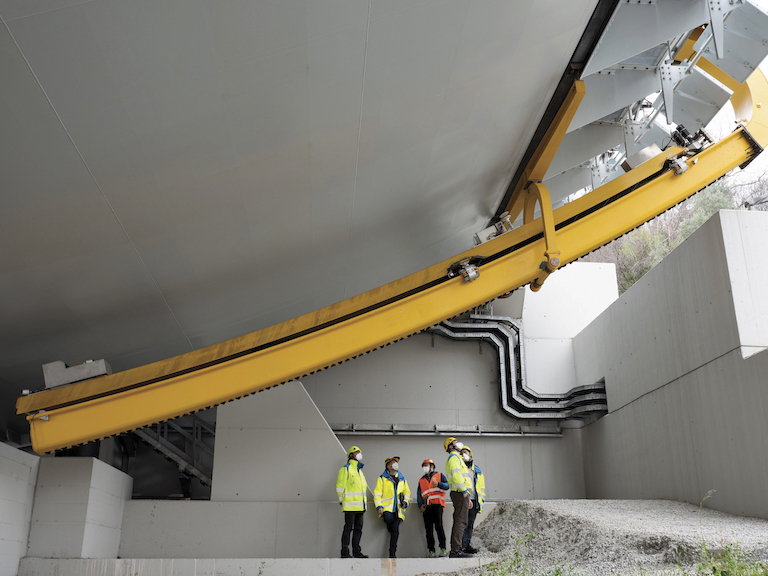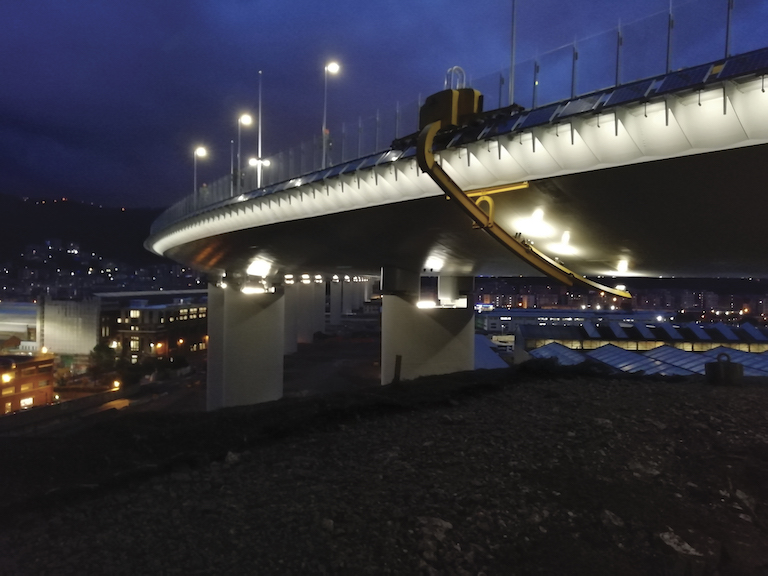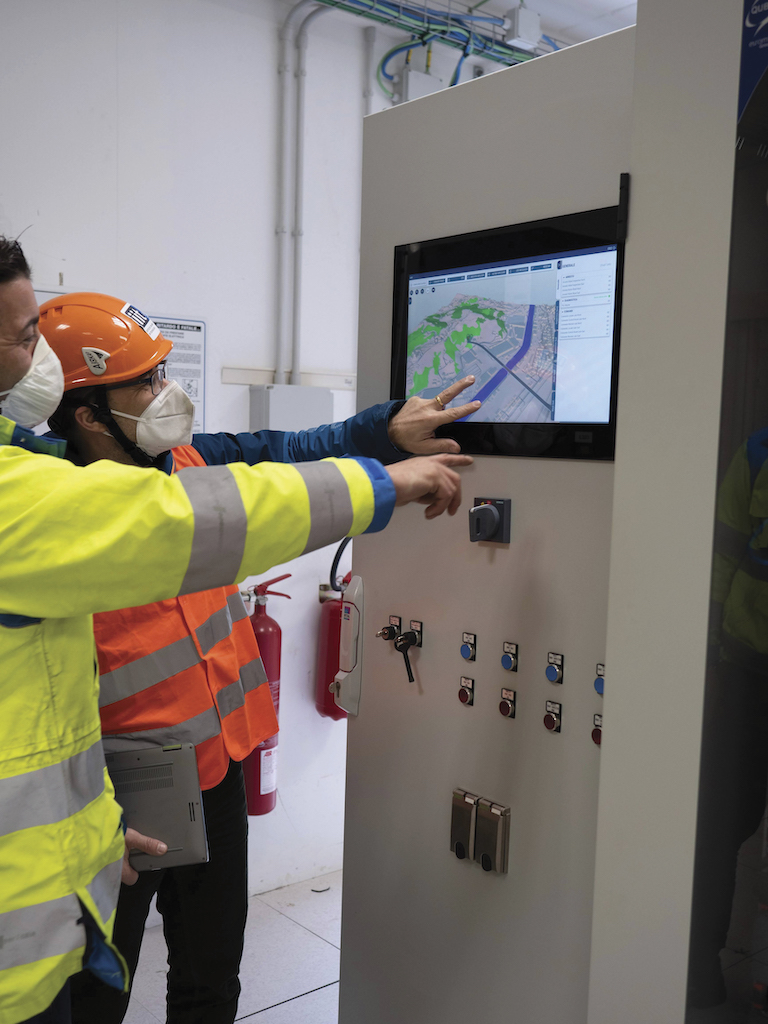The 2018 collapse of the Morandi Bridge was international news. Completed in 1967, the bridge carried the A10 motorway over the Polcevera Valley in Genoa, Italy. The dramatic collapse and deaths of 43 people shocked Europe, particularly an Italian engineering community that prides itself on a long legacy of engineering excellence. Many theories have been put forward regarding the cause of the collapse, ranging from very human lapses in maintenance and judgment to a lightning strike on a primary cable stay. As of this writing, the cause of the collapse is still under investigation. But this isn’t a story about the Morandi Bridge collapse. It’s the story of what came next.

The Morandi Bridge was a critical link between communities in Genoa and the broader Liguria region of Italy. The loss of the motorway led to a year-long state of emergency and urgent pressure to design and build a replacement bridge as soon as possible. However, this replacement faced a slew of technical and societal challenges. A coastal city, Genoa has been known for its naval prowess for millennia, relying on its steady winds to send ships abroad. The Polcevera Valley serves to amplify these coastal winds, often accompanied by powerful storms. The designers didn’t just need to consider complex environmental conditions but also complex psychological conditions. Perhaps more than any of us fully realize, civil engineering is an act of trust between builders and the communities they serve. Regardless of the cause of the Morandi collapse, the event shattered the public’s trust in the safety of their infrastructure.
It is worth considering historical precedent to understand how designers address the psychological aspects of collapse. One of the most well-known and publicized bridge collapses ever was the Tay Rail Bridge disaster in Scotland. Constructed in 1878, the bridge was a technological marvel of its time. It employed a combination of complex truss latticework and cast-iron materials in the same manner used in the Crystal Palace and Gustave Eiffel’s Massif Central viaducts. But in 1879, only 19 months after opening to the public, the bridge collapsed in high winds, killing the 75 passengers of a rail train crossing at the time. At the time of the collapse, another railway bridge was being designed to cross the nearby Firth of Forth. An analysis of the collapse led to a complete redesign of what would be known as the Firth of Forth Bridge. The redesign included an aesthetic emphasis on creating an iconic bridge that looked indestructible. That bridge is now a UNESCO world heritage and a significant tourist attraction for visitors to Edinburgh.
How was Genoa to recreate this process in the 21st century? It would not be enough to make the bridge look sturdy it also needed to symbolize Genovese resilience. Renzo Piano was just the man to accomplish that. Renzo Piano is, by any measure, one of the greatest architects working today and has designed countless iconic structures worldwide, including The Shard in London and the Pompidou Center in Paris. When he won the Pritzker Architecture Prize in 1998, he was compared to Michelangelo and Da Vinci, no small comparison for the Italian national icon. He also happens to be Genovese. Who better to lead the design of the Morandi replacement?
Piano’s design went straight to the point: Genoa has been a sea power for millennia. The new bridge would celebrate that remarkable heritage while instilling a sense of solidity and security. It also had to handle the high winds of the Polcevera Valley, and construction speed was paramount, two critical factors for the bridge’s design. The result was the new San Giorgio Bridge, with an elliptical profile that evokes a ship hull while providing optimal wind resistance. Internal to the elliptical “hull” is a steel box truss design that could be rapidly fabricated and assembled, reflecting a successful partnership between architect and engineer. The Morandi was a visually dramatic cable-stayed design. The San Giorgio is sleek, modern, and minimalist.
The design is beautiful and efficient, yet it did not address the psychological impacts of rebuilding after a collapse. Not only that, but Piano’s design created two significant difficulties. The sound and wind barriers on the roadway were clear glass, which Piano insisted on so that motorists could take in the beauty of his iconic hometown. Maintaining that beautiful view meant keeping the glass consistently clean. Additionally, the combination of high winds and the elliptical profile of the bridge meant that traditional inspection equipment like snooper trucks and even modern inspection systems like drones would be infeasible. In short, the bridge would be a maintenance headache. Since some forensic studies pointed to maintenance problems as the cause of the Morandi collapse, this was not a trivial concern.

The Istituto Italiano di Tecnologia (IIT) proposed a novel solution. They would design a team of robots that would be integrated into the bridge itself. One robot, “RobotWash,” would be tasked with cleaning the bridge, particularly the glass barriers and solar panels. The other robot, “InspectionRobot,” would inspect the ship-like structural exterior while serving as a highly visible manifestation of structural safety. Most importantly, these robots would work as part of a team with an integrated structural health monitoring system, forming a state-of-the-art digital twin of the bridge. Managers and engineers could dynamically interact with this digital twin in a high-tech command and control center to make maintenance and inspection decisions. Piano’s design was beautiful, but IIT’s was bleeding edge tech. The design and construction of the robots were done in partnership between IIT and Camozzi Group, a major producer of industrial automation systems, and a consortium that included SDA (the structural designer), Università Politecnica of Marche (the defect detection system designer) and Ubisive (the human machine interface designer).
Each robot design was a first of its kind. RobotWash needed to traverse the length of the bridge on an integrated rail system, with a payload of cleaning brushes and accessories, like an automatic car wash. Given the similarities, the team at IIT brought in rollercoaster engineers to help with the design. The biggest challenge was the difference in construction tolerances between rollercoasters and bridges, which generally differ by order of magnitude.

RobotWash was a challenging design, but InspectionRobot required innovation on an entirely different scale. Again, the high wind environment and one-of-a-kind structural design meant that commercially available inspection technologies weren’t feasible. Eventually, the design for InspectionRobot settled on a huge robotic arm that could deliver a sensor payload of cameras and non-destructive testing equipment to any location on the bridge hull. The information from these sensors, combined with localization data from the robot, would allow the generation of a high-resolution 3D model of the bridge exterior, which could be continuously analyzed by humans and AI systems back at the bridge command center. Just like the design of the bridge, the design of InspectionRobot was governed by wind forces. Numerical simulations of the robot arm showed that it would be subjected to severe Venturi forces and various harmonic effects. It would also have to be massive, weighing over 5,000 pounds and telescoping to cantilevered lengths of over 25 feet, making it almost impossible to construct. The answer was to 3D print the robotic arm out of carbon fiber to reduce its self-weight. The 3D printing also allowed the team to design optimal windbreaks along the arm’s length to reduce the Venturi effect forces.
The complexity of the working environments and the intricate robotic designs meant that both robots needed to operate autonomously with minimal human intervention. InspectionRobot, operating almost continuously, would generate massive amounts of data that needed to be aggregated and analyzed in conjunction with the integrated sensor system. Engineers and managers needed to be able to engage with the complete set of bridge data interactively and intuitively, so the bridge needed a brain, or at least as close as we’re able to come today. Just off-site from the bridge is a facility that houses the servers and data storage for the bridge. While the idea of a high-performance computer for a bridge is remarkable on its own, the most interesting aspect of the facility is the intuitive digital twin interaction system that allows engineers to visualize bridge data, evaluate the behavior and performance of the robots themselves, engage with AI-driven recommendations, and manage robot activities. It is a remarkable design of human-machine interactivity that sets the standard for the emerging field of digital twin-driven structure management.

Here’s the kicker: not only is this one of the most cutting-edge bridges in the world but it was all built in less than a year. While IIT and Camozzi worked furiously on the design and manufacturing of the robots, Fincantieri led the fabrication and construction of the bridge. The 3.5-kilometer bridge was inaugurated in August 2020, a little over one year from construction and almost two years after the Morandi collapse. That any large bridge could be designed and built within that time frame is an engineering achievement. That it could also serve as a technological and architectural paragon is nothing short of remarkable.
What does the San Giorgio Bridge mean for the future of our profession? Are we all going to need to become roboticists? The San Giorgio Bridge’s unique circumstances drove the integrated robotics concept, and it is unlikely that every bridge will have its own robot workforce. But drones and inspection robots continue evolving into essential bridge inspection and management tools, as are digital twin systems. While RobotWash and InspectionRobot probably aren’t coming to a highway overpass near you, they show an exciting path forward for robotics, advanced computing, and human-machine interaction in our industry. Our challenge is to figure out how to embrace these ideas to innovate how and where we build and train future generations of engineers who will work with these technologies.
